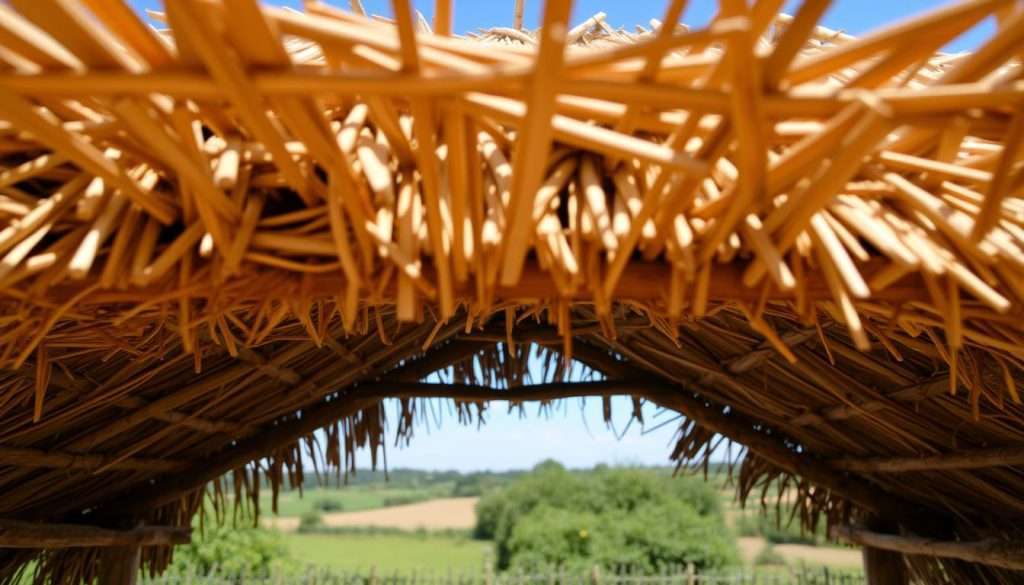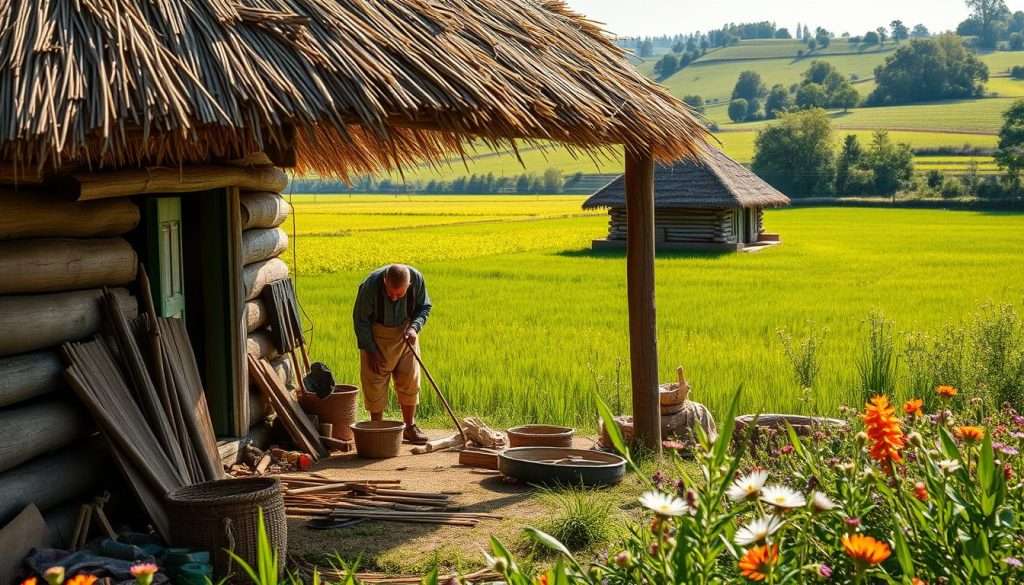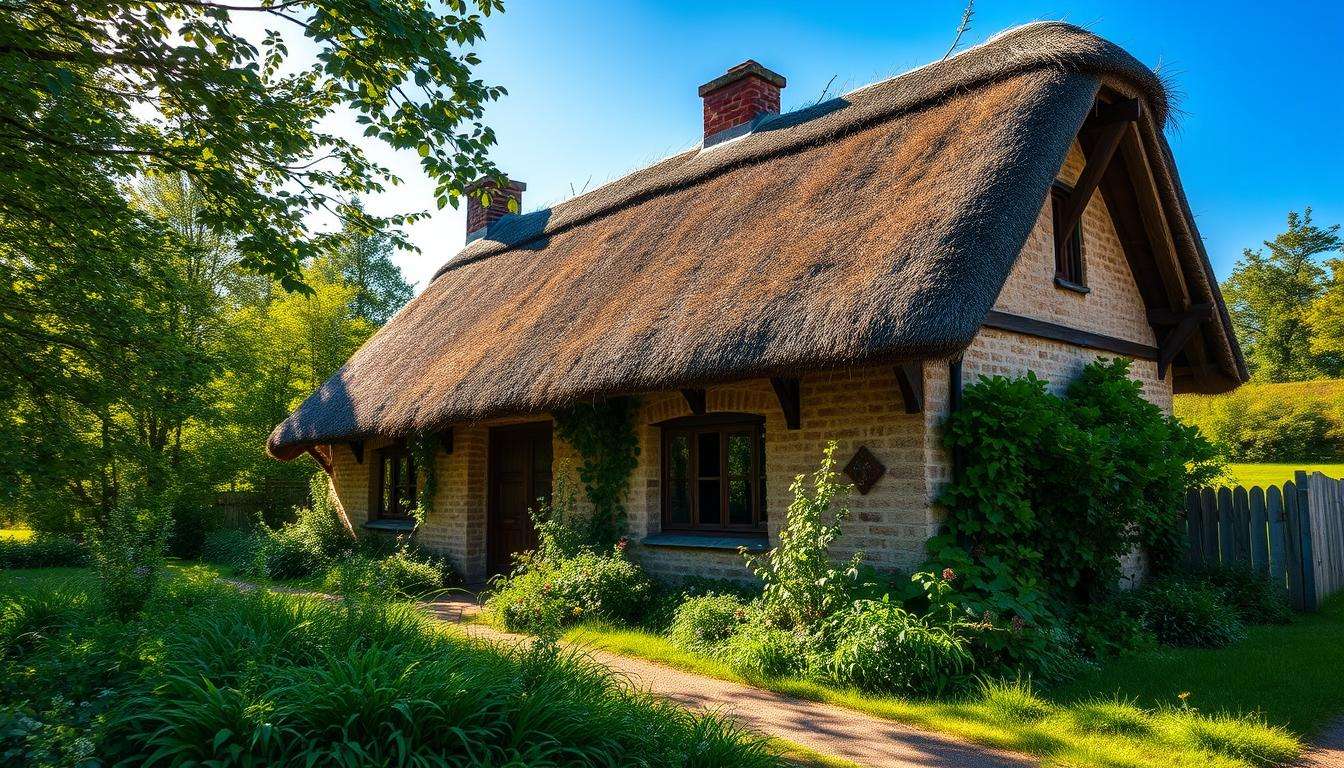Thatched roofs are very beautiful. They are often seen on old cottages and buildings. This thatched roof definition means roofs made from straw, water reeds, or heather. They look very special and many people love them.
Thatched roofs have been around for a long time. They are not just pretty; they also work well. These roofs keep water out, with only a little bit getting in. If taken care of, they can last 25 to 50 years.
It’s important to pick the right thatched roof materials for them to last. Wheat straw and water reed are good choices because they are strong. If you want a thatched roof, knowing how to take care of it is key. For more info, click here: everything you need to know about thatched.
What is a Thatched Roof?
A thatched roof is made from dried plants like straw or reeds. These plants are stacked to keep water out. This old way of roofing has been around for thousands of years.
It’s very common in the UK and Europe. Skilled thatchers have kept this tradition alive for generations. They show us the beauty and skill of thatched roofs.
Definition and Origin
Thatched roofs are made from natural materials. They look good and work well. This roofing method is over 10,000 years old.
In 2013, about 60,000 homes in the UK still had thatched roofs. This shows that people still love this old roofing style.
Historical Context
Thatched roofs have a rich history. They were once common in rural areas. They showed off the beauty of living in the countryside.
But, by the late 1800s, they became less popular. In the US, they almost disappeared. Now, people are starting to like them again because they’re good for the planet.
In the Netherlands, over 150,000 homes have thatched roofs. This shows that thatched roofs are still a good choice today.
Components of a Thatched Roof
A thatched roof has many parts that work together. It uses natural materials and special techniques. This makes it both beautiful and useful. Let’s look at the materials, how it’s made, and why natural thatch is good.
Common Materials Used
Thatched roofs use different natural materials. Here are some:
- Water Reed: Lasts over 60 years and is cheap in the UK.
- Wheat Reed: Lasts 25 to 35 years and keeps warm.
- Long Straw: Lasts 15 to 25 years and looks rustic.
- Other Materials: Heather, Turf, Sedge, Rye Straw, and Veldt Grass have different looks and lasts.
Thatching Techniques
There are many ways to thatch a roof. These methods make roofs strong and look good. Here are some:
- Single-layer Construction: Thatch is put directly on rafters for a simple roof.
- Multi-layer Technique: Uses a base layer for a thicker, stronger roof.
- Ridge Styles: Ridges can be different, like Block Finish or Wrap Over Ridge, each adding its own look.
Benefits of Using Natural Thatch
Choosing natural thatch has many benefits. It’s good for the planet and looks great. Here are some reasons:
- Excellent Insulation: Thatch keeps heat in, saving energy.
- Sustainability: Thatch materials are renewable and don’t harm the environment.
- Distinctive Charm: Thatch makes buildings look unique and charming.

| Material | Average Lifespan | Cost-effectiveness |
|---|---|---|
| Water Reed | 60+ years | High |
| Wheat Reed | 25-35 years | Moderate |
| Long Straw | 15-25 years | Lower |
| Heather | Varies | Moderate |
| Turf/Sedge/Rye Straw | Varies | Lower |
Advantages of Thatched Roofs
Thatched roofs are both practical and charming. They look great and have many benefits. Let’s explore why they’re so special.
Aesthetic Appeal
Thatched roofs add a whimsical touch to any home. They bring a rustic charm that’s hard to find elsewhere. This unique look makes homes more attractive and valuable.
Environmental Benefits
Thatched roofs are great for the environment. They use natural materials that are good for the planet. Plus, they help local economies by supporting jobs in rural areas.
Insulation Properties
Thatched roofs are also good at keeping your home warm. They help control temperatures, saving you money on heating and cooling. With the right care, they can last up to 60 years.
| Feature | Advantages |
|---|---|
| Aesthetic Appeal | Enhances property’s character with unique charm |
| Eco-Friendly | Sustainable sourcing and biodegradable materials |
| Insulation | Natural insulation reducing energy costs |
| Longevity | Lasts up to 60 years with proper maintenance |
Maintenance and Longevity
Keeping your thatched roof in good shape is key to its long life. With the right care, a natural roof can last 20 to 30 years. But, many things can affect how long it lasts. Regular checks can spot problems early, saving you money.
Routine Care Tips
To keep your roof lasting longer, follow these tips:
- Look for loose thatch or holes.
- Watch for pests like birds or rodents.
- Use sprays to protect from the sun, especially in harsh weather.
- Check your roof twice a year, before hurricane season, to find hidden issues.
- Use treatments to protect against salt air in coastal areas to prevent corrosion.
Signs of Wear and Tear
Spotting problems early can save you from big repair costs. Look out for these signs:
- Visible holes or gaps in the thatching.
- Discoloration or sagging areas.
- More pests around the roof.
- Debris that traps moisture and can cause mold.
When to Replace or Repair
Deciding when to fix or replace your roof is crucial. Consider these points:
- Get a pro to check if you need to rethatch, usually every 10 to 15 years.
- Palm thatch roofs might need rethatching every 5 to 7 years.
- Fix big problems quickly to make your roof last longer.

Good maintenance can keep your roof looking and working great for years. Using quality materials and skilled workmanship when you first install it helps a lot. This way, you won’t need to do as much upkeep.
| Material | Average Lifespan | Maintenance Frequency |
|---|---|---|
| Water Reed | 40 years+ | Every 10-15 years |
| Combed Wheat Reed | 35 years | Every 10-15 years |
| Longstraw | 25 years | Every 10-15 years |
| Ridge (Straw) | 10-15 years | Every 10-15 years |
Thatched Roofs in Modern Architecture
Thatched roofs are coming back in modern buildings. They add charm and save energy. Architects mix old and new styles, making buildings look great and work well.
These roofs fit many types of buildings. They work in eco-homes and city buildings too. The use of thatched roofs shows they are very flexible.
Contemporary Applications
Recently, thatched roofs have become popular again. Architects are making old designs new. They use new materials and ideas.
For example, the Museum & Biodiversity Research Center in France uses thatch in a new way. Other projects include:
- An old farmhouse in the Netherlands was fixed up to be green.
- The Diamond Island Community Center in Vietnam uses thatched roofs to show culture and look good.
- Nid Vu, Nid Connu in France uses local materials to be eco-friendly.
Notable Examples in the US
In the US, thatched roofs are not common but are getting noticed. The first vertical thatched house in the Netherlands has sparked interest. Architects like Kengo Kuma are making new thatched designs.
Projects like the Am House in Vietnam show thatched roofs can keep buildings cool. They mix old and new in a cool way.
Challenges in Urban Settings
Putting thatched roofs in cities is hard but worth it. Laws and finding good materials are big problems. Fire safety is also a big worry.
But, with careful planning and creative ideas, it can work. Thatched roofs can fit in cities.
| Project | Location | Architect | Features |
|---|---|---|---|
| Diamond Island Community Center | Vietnam | N/A | Cultural architecture with thatched domes |
| Museum & Biodiversity Research Center | France | N/A | Modern reinterpretation of thatched roofs |
| Am House | Vietnam | N/A | Intended for thermal regulation |
For more on thatched roofs, check out this article.
The Future of Thatched Roofing
Thatched roofs are becoming more popular. People love their beauty and how good they are for the planet. We’re seeing more use of natural materials and old skills in building.
This trend is great for our culture and the environment. It shows we care about how we build things.
Trends and Innovations
New tech is making thatched roofs better. For example, there’s a fire-safe thatch made from PVC. It lasts over 20 years and needs little upkeep.
This means you can have a thatched roof that’s safe and lasts long. It’s a hit for places like hotels and resorts in the U.S.
Sustainable Practices
Using green roofing is key for the future. Thatched roofs use straw and reeds, which are good for the planet. They keep your house cool in summer and warm in winter.
Building with straw and reeds shows you care about the environment. Plus, the skills needed for thatching are passed down through families. This helps keep old ways alive and supports local jobs.
Preserving Traditional Craftsmanship
We need to keep old building skills alive. As more people want thatched roofs, we must support the experts. They make sure these roofs stay true to their roots.
Their skills are vital. They help make thatched roofs fit for today without losing their special charm.
